Rain chains, popularly known as kusari-doi, came to us from Japan. There, gardeners have used this decorative method for centuries to direct water runoff from the roofs of temples and homes and beautify landscapes.
More recently, the chains have gained popularity worldwide, with many in the United States opting to utilize them in place of the traditional gutter downspouts.
They’re not only affordable but are also easy to install, are less likely to clog, and produce a relaxing sound when water runs through them. Rain chains also maintain their aesthetic appeal as they age, unlike traditional downspouts.
There are mainly two types of rain chains—link and cup chain style. You can either choose to buy or make one yourself.
Frequently Asked Questions About Rain Chains
Before we get into the enjoyable DIY process, here are the answers to some of the commonly asked questions about these beauties.
What does a rain chain do?
Unlike downspouts, rain chains beautifully direct rainwater from gutters to decorative water vessels or drains, turning the relatively unexciting activity into a mesmerizing water feature.
Are rain chains a good idea?
Rains chains are great if you need an on-the-spot functional and eye-catching roof-water management tool rather than having to redirect the runoff to another section of the roof. If installed properly, they work perfectly well, just as a downspout gutter system.
Do rain chains work in heavy rain?
Every type of rain chain is different; however, most of them require backup downspouts to handle the excess water pressure. This is because, unlike the traditional downspouts, they’re less sturdy and have less water-holding capacity.
Below are the best five you can try if you reside in an area prone to very heavy downpours:
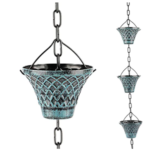
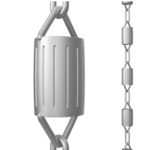
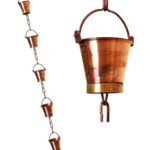
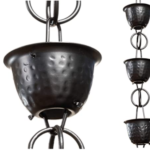
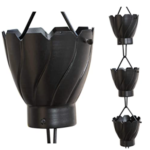
Do rain chains make noise?
Though they don’t exhibit any direct sounds, rain chains still make soothing sounds when rainwater flows through them.
How do you install a rain chain without gutters?
It’s a fact that most sloping roofs will easily accommodate rain chains even without a gutter; however, the trajectory of the water flow from the roof through the crease or crevice (during a storm) may differ from home to home considering the varying nature of roof slopes.
And so, before you do the installation, be sure to study how your roof expels water.
- Observing and identifying the corner of your roof during a rainstorm that vertically streams rainwater.
Hint: This should be a crease or a sloped area or a corner where two sections of the house meet.
- Make a wide enough hole in the bottom of your chosen bucket that allows a 2-inch S-hook to dangle through.
- Screw the eyehook where you would like your rain chain to hang. This should be in the soffit under your roof crease.
Ensure the eyehook is positioned approximately an inch from the soffit’s edge—to allow most of the bucket’s mouth to capture as much of the streaming rain.
- Detach the bucket’s handle and slip it through the eyehook. Attach the handle to the bucket.
- Lay a metal rod across the base of the bucket. Secure the S-hook to the rod, ensuring that it (the S-hook) dangles via the hole in the bottom of the bucket.
- Attach your rain chain to the S-hook, letting it dangle down to a water vessel or a drain.
Note: Be sure to have a splashboard under the water vessel—with the sloppy side of the board starring away from your property.
Can I hang a rain chain from a tree?
Rain chains are quite a versatile décor item; you can use them as a downspout replacement and distinct tranquil addition to your garden setting—whereby you hang the chains from trees or utilize them in conjunction with water fountains.
What do you put at the bottom of a rain chain?
A barrel, French drain, or a basin will effectively help hold the water runoff from rain chains. Alternatively, if your yard slopes away from the building, you can just let it run off into the groundwater.
How do you divert rain without gutters?
Do you hate maintaining your gutters? Try rain chains. Other great alternatives to regular gutters include Rain Dispersal Systems, Grading, Drip Edge, French Drain or Ground Gutter, Drip Path, and Built-in Gutters.
Can I use a regular chain for rain chain?
You can use pretty much anything that can be strung into a single piece. This includes regular chains, shower rings, or even keyrings.
How to Create a Rain Chains (a fun afternoon DIY project!)
Requirements for a single-story home (double everything in the case of a two-story):
- 2 large S-hooks
- About 9 feet of ½ inch chain
- 9 small S-hooks
- 9 galvanized pails (bucket) or any decorative pots of your choice
- A drill with ½ inch (1.3 cm) drill bit
- Pliers
Steps
- On the handle of every pail, attach one small S-hook, then use pliers to secure the hook.
- Drill a slightly wider hole (than the chain) through the bottom of every pail, then pull through the chain via the holes, making sure to leave approximately eight inches from the top.
- Secure each pail on the chain using the open end(s) of the S-hook (s) on the handle.
- Attach one large S-hook on the chain’s bottom to connect it to an anchoring pot, rain barrel, or dish and continue the installation.
Be sure to follow the manufacturer’s directions when attaching your chain brand to the gutter.
Maintenance of Rain Chains
- Remember that rainwater and the chain will rest their weight on the eave. And so, be on the lookout for any stress signs to the roof structure.
- Offer reinforcement or remove the rain chain to avoid roof damage if need be.
- Also, inspect the ground around your rain chain (periodically) for erosion indicators. If noted, switch to a larger anchoring dish or add more rocks.
- Ensure the water that ends up on the ground flows effortlessly away from your property.
- Lastly, inspect and clean your gutter system at least twice a year to enhance efficiency.
The Takeaway: Rain Chains Make a Beautiful Alternative to Traditional Gutter Downspouts
They may not be as robust and high-capacity as downspouts but still will deliver their intended purpose. To maximize the efficiency and effectiveness of your rain chains, consider using them alongside other rainwater harvesting systems.


